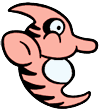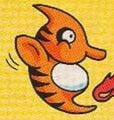Yurarin: Difference between revisions
From the Super Mario Wiki, the Mario encyclopedia
Jump to navigationJump to search
m (Text replacement - "{{[Ss]pecies-infobox" to "{{species infobox") |
|||
| Line 1: | Line 1: | ||
{{species | {{species infobox | ||
|image=[[File:SML Yurarin Alternate Artwork.png]] | |image=[[File:SML Yurarin Alternate Artwork.png]] | ||
|first_appearance=''[[Super Mario Land]]'' ([[List of games by date#1989|1989]]) | |first_appearance=''[[Super Mario Land]]'' ([[List of games by date#1989|1989]]) | ||
Revision as of 21:58, April 20, 2022
| Yurarin | |||
|---|---|---|---|

| |||
| First appearance | Super Mario Land (1989) | ||
| |||
Yurarin[1][2] are seahorse enemies found in the Muda Kingdom in Super Mario Land, described as Dragonzamasu's underlings.[1] Yurarin's attack patterns are very simple and easy to dodge. They simply float around at a slow speed, trying to hit Mario. Mario is awarded 400 points for shooting one twice with torpedoes supplied by his Marine Pop. They are only found in World 2-3 of the Muda Kingdom, the Marine Pop's stage. The big brothers of Yurarin, named Yurarin Boos, appear exclusively in the same kingdom as well. The only real difference between a Yurarin and a Yurarin Boo is that Yurarin Boo have the ability to shoot fire while Yurarin do not.
Profiles
Super Mario Land
- Instruction booklet: "This underling of Dragonzamasu lives in the water and trembles as it swims along. 2 torpedoes will defeat it."[1]
- Game Boy Player's Guide: "You’ll meet seahorses underwater."[2]
- 3DS Virtual Console manual: "This underwater underling of Dragonzamasu trembles as it swims along. Defeat it with two torpedoes."
Gallery
Names in other languages
| Language | Name | Meaning |
|---|---|---|
| Japanese | ユラリン[3] Yurarin |
Derived from「ゆらり」(yurari, an adverb meaning "unstably") |
| German | Yurarin |
Yurarin |
| Spanish | Yurarin |
Yurarin |
References
| Super Mario Land | |
|---|---|
| Protagonists | Mario • Princess Daisy |
| Bosses | King Totomesu • Dragonzamasu (Tamao) • Hiyoihoi • Biokinton (Chicken) • Tatanga (Pagosu) |
| Locations | Sarasaland (Birabuto Kingdom • Muda Kingdom • Easton Kingdom • Chai Kingdom) |
| Levels | World 1-1 • World 1-2 • World 1-3 • World 2-1 • World 2-2 • World 2-3 • World 3-1 • World 3-2 • World 3-3 • World 4-1 • World 4-2 • World 4-3 • Expert Level |
| Items & vehicles | Super Mushroom • Superball Flower • Star • 1UP heart • Coin • Marine Pop • Sky Pop • Switch • Lift Block |
| Enemies & obstacles | Batadon • Bombshell Koopa • Bullet Biff • Bunbun • Chikako • Dropping lift • Falling block • Falling spike • Fly • Ganchan • Gao • Gunion • Goombo • Honen • Kumo • Mekabon • Nyololin • Pionpi • Pipe Fist • Piranha Plant • Pompon Flower • Roketon • Roto Disc • Suu • Tokotoko • Torion • Yurarin • Yurarin Boo |
| Other | Brick • Bonus game • Das Super Mario Spiel • Gallery • Glitches • Goal • Media • Mystery Block • Soundtrack |
